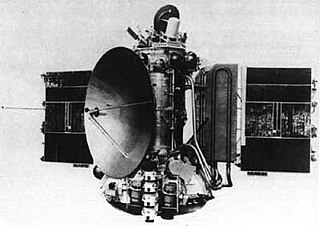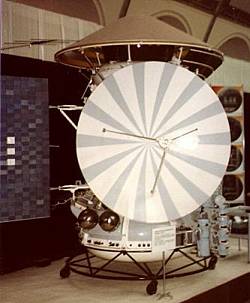
Venera 1, also known as Venera-1VA No.2 and occasionally in the West as Sputnik 8 was the first spacecraft to perform an interplanetary flight and the first to fly past Venus, as part of the Soviet Union's Venera programme. Launched in February 1961, it flew past Venus on 19 May of the same year; however, radio contact with the probe was lost before the flyby, resulting in it returning no data.
Venera 2MV-1 No.2, also known as Sputnik 20 in the Western world, was a Soviet spacecraft, which was launched in 1962 as part of the Venera programme. Due to a problem with its upper stage it failed to leave low Earth orbit, and reentered the atmosphere a few days later. It was the second of two Venera 2MV-1 spacecraft, both of which failed to leave Earth orbit. The previous mission, Venera 2MV-1 No.1, was launched several days earlier.
Mars 2MV-4 No.1 also known as Sputnik 22 in the West, was a Soviet spacecraft, which was launched in 1962 as part of the Mars programme, and was intended to make a flyby of Mars, and transmit images of the planet back to Earth. Due to a problem with the rocket which launched it, it was destroyed in low Earth orbit. It was the first of two Mars 2MV-4 spacecraft to be launched, the other being the Mars 1 spacecraft which was launched eight days later.
Mars 2MV-3 No.1 also known as Sputnik 24 in the West, was a Soviet spacecraft, which was launched in 1962 as part of the Mars program, and was intended to land on the surface of Mars. Due to a problem with the rocket which launched it, it did not depart low Earth orbit, and it decayed several days later. It was the only Mars 2MV-3 spacecraft to be launched.
Kosmos 21 was a Soviet spacecraft. This mission has been tentatively identified by NASA as a technology test of the Venera series space probes. It may have been an attempted Venus impact, presumably similar to the later Kosmos 27 mission, or it may have been intended from the beginning to remain in geocentric orbit. In any case, the spacecraft never left Earth orbit after insertion by the Molniya launcher. The orbit decayed on 14 November 1963, three days after launch.

Mars 4, also known as 3MS No.52S was a Soviet spacecraft intended to explore Mars. A 3MS spacecraft launched as part of the Mars programme, it was intended to enter orbit around Mars in 1974. However, computer problems prevented orbital insertion from occurring.
Mars 5, also known as 3MS No.53S was a Soviet spacecraft launched to explore Mars. A 3MS spacecraft launched as part of the Mars programme, it successfully entered orbit around Mars in 1974. However, it failed a few weeks later.

Mars 6, also known as 3MP No.50P was a Soviet spacecraft launched to explore Mars. A 3MP bus spacecraft launched as part of the Mars program, it consisted of a lander, and a coast stage with instruments to study Mars as it flew past.

Mars 7, also known as 3MP No.51P was a Soviet spacecraft launched in 1973 to explore Mars. A 3MP bus spacecraft which comprised the final mission of the Mars programme, it consisted of a lander and a coast stage with instruments to study Mars as it flew past. Due to a malfunction, the lander failed to perform a maneuver necessary to enter the Martian atmosphere, missing the planet and remaining in heliocentric orbit along with the coast stage.

Mars 1M was a series of two uncrewed spacecraft which were used in the first Soviet missions to explore Mars. They were the earliest missions of the Mars program. The Western media dubbed the spacecraft "Marsnik", a portmanteau of Mars and Sputnik.

Venera 2, also known as 3MV-4 No.4 was a Soviet spacecraft intended to explore Venus. A 3MV-4 spacecraft launched as part of the Venera programme, it failed to return data after flying past Venus.
Venera 2MV-2 No.1, also known as Sputnik 21 in the West, was a Soviet spacecraft, which was launched in 1962 as part of the Venera programme, and was intended to make a flyby of Venus. Due to a problem with the rocket which launched it, it failed to leave low Earth orbit, and reentered the atmosphere a few days later. It was the second Venera 2MV-2 spacecraft, both of which failed to leave Earth orbit.
Mars 2M No.522, also known as Mars M-69 No.522 and sometimes identified by NASA as Mars 1969B, was a Soviet spacecraft which was lost in a launch failure in 1969. It consisted of an orbiter. The spacecraft was intended to image the surface of Mars using three cameras, with images being encoded for transmission back to Earth as television signals. It also carried a radiometer, a series of spectrometers, and an instrument to detect water vapour in the atmosphere of Mars. It was one of two Mars 2M spacecraft, along with Mars 2M No.521, which was launched in 1969 as part of the Mars program. Neither launch was successful.

1971 saw the last three known deaths of cosmonauts of the Soviet space program and the only deaths in space. Their mission was to man humanity's first space station. The experimental bay door failed to separate so the first crew failed to dock and second crew were killed on re-entry. 1971 also saw the launch of the first and only British satellite on top of a British rocket after that success the program was cancelled.

The Molniya-M, GRAU designation 8K78M, was a Soviet Union launch vehicle derived from the R-7 Semyorka Intercontinental ballistic missile (ICBM).
Zond 3MV-1 No.2, also known as Venera 1964A in the West, was a Soviet spacecraft, which was launched in 1964 as part of the Zond program. Due to a problem with its carrier rocket third stage, it failed to reach low Earth orbit.

Mars 1M No.1, designated Mars 1960A by NASA analysts and dubbed Marsnik 1 by the Western media, was the first spacecraft launched as part of the Soviet Union's Mars programme. A Mars 1M spacecraft, it was intended for conducting flight testing system and to study the interplanetary environment between Earth and Mars, however it was lost in a launch failure before it could begin its mission.

A Mars flyby is a movement of spacecraft passing in the vicinity of the planet Mars, but not entering orbit or landing on it. Uncrewed space probes have used this method to collect data on Mars, as opposed to orbiting or landing. A spacecraft designed for a flyby is also known as a "flyby bus" or "flyby spacecraft".
Kosmos 96, or 3MV-4 No.6, was a Soviet spacecraft intended to explore Venus. A 3MV-4 spacecraft launched as part of the Venera programme, Kosmos 96 was to have made a flyby of Venus. However, due to a launch failure, it did not depart low Earth orbit. Its re-entry into Earth's atmosphere is often speculated as the cause of the Kecksburg UFO incident.
Kosmos 167, or 4V-1 No.311, was a 1967 Soviet spacecraft intended to explore Venus. A spacecraft launched as part of the Venera programme, Kosmos 167 was intended to land on Venus but never departed low Earth orbit due to a launch failure.











